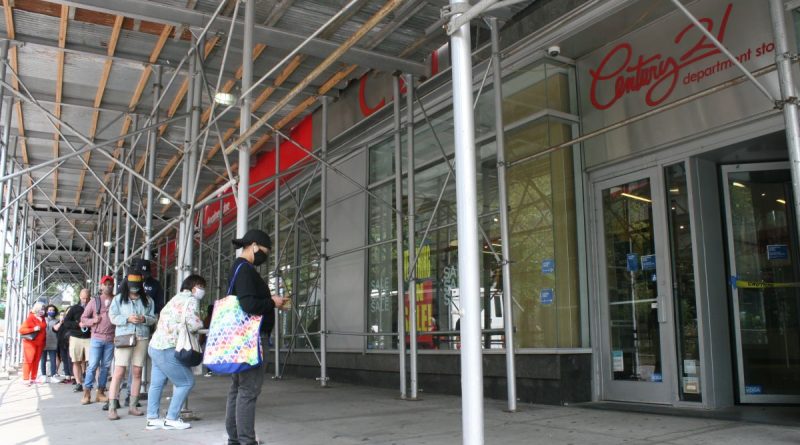What also devastated the pandemic in NYC: 1,000 closed chain stores and 50% of restaurants almost bankrupt | The State
In the wake of this new 2021 it is still a question of understanding the dimensions of the immense ‘crater’ that the COVID-19 pandemic leaves the economy of the Big Apple. Everything outlines that bankruptcy and business closing, unfortunately, it will continue to be present on the horizon for the next few months.
New York City icons such as chain stores on every corner, its diverse array of restaurants, and even the “hornet’s nest” of yellow cabs in the urban scene, are experiencing a real crash.
Some academic reports already describe what happened in 2020 with famous chains from fast food restaurants, smartphone sales, pharmacies and at least 200 kinds of retail business models.
He Center for an Urban Future published a study stating that the pandemic forced the permanent or temporary closure of more than 1,000 stores of this category in all five counties.
“The number of retailers in these chains decreased from a total of 7,948 in 2019 to 6,891 stores in 2020, a decrease of 13.3 percent ”, details the extensive report product of a data collection between November and December of the 2020 pandemic.
Overall, 2% of these store categories in New York City have reported that their measures are temporary and 11.3% have not. specified if the closures are permanent.
198 stores closed in Queens
Just an example. When last September the “cheap” clothing chain Century 21 announced the closure of its nine stores in New York City, after reporting its bankruptcy due to the effects of the coronavirus, at least 1,400 people were unemployed. One of them was Colombian Giselle Matos, 45 years old, who worked as a cashier in one of its huge warehouses.
“I had been working in that chain for 10 years and we cried a lot when they told us they couldn’t take it anymore. We top it all. It’s been three months and it doesn’t look easy to get another job. Rather one feels that every time you walk down a street there is a new business that they closed ”, shares Matos who lives in Forrest Hill in Queens.
And it was precisely in Queens, the second county after Manhattan, where more closures were confirmed. There a total of 198 stores of well-known chains or franchises closed their doors. This represents 11.2 percent of the total number of businesses of this type in that locality.
Some neighborhoods were hit hardest, according to the report.
Specifically, more than 25% of the chain stores in the ZIP Code 11102 belonging to Astoria and zip code 11413 of Springfield gardens they did not continue to operate commercially in 2020.
Other numbers show the economic meltdown: 28 percent of JFK airport stores also went out of business or put a hiatus before abysmal decrease in visitors to the Big Apple.
“Last year was marked by unprecedented economic volatility in most sectors in all counties of the city, the national retail market experienced an unprecedented contraction as a result of the COVID-19 outbreak, “the authors of the‘ Center for Urban Future ’report highlighted.
Those most affected: minority youth
He Dominican José Miguel Feliz, 22 years old, worked as a maintenance assistant at a branch of the gym chain New York Sport Club, on the Upper West Side of Manhattan. When these establishments were allowed to reopen last summer, the young man expected to be called upon to rejoin. But the communication he received is that this headquarters, like 26 others, would not open “for now”.
“I helped my family. I had a dream to start studying at the university, but that plan will have to wait, ”said Feliz.
With an average unemployment rate of around 14.5% at the end of last year, other investigations report who are those who have suffered the most from the calamity of the business closure in general.
In a report published by The New York Times, Stephanie Aaronson, director of economic studies at ‘Brookings Institution’ concludes that the loss of jobs due to the pandemic has particularly affected young workers who are Black, Hispanic or without a college degree.
“They have even higher unemployment rates than younger workers in general. They are also more likely to have difficulties because their families they don’t have the resources to support themAaronson said.
Furthermore, as can be seen from an analysis of ‘The New School‘At the New York City Affairs Center, the 19 percent of adults under the age of 25 in the city they had lost their jobs compared to 14 percent of all workers.
While workers under the age of 25 made up only 10 percent of the city’s total workforce of 4.8 million before the pandemic, they had the 15 percent of jobs in service industries hardest hit, including restaurants, retail stores, entertainment and recreation.

The agony of restaurants
If an industry defines the life of the city of skyscrapers, it is bars and restaurants. After a long agony that began in the spring for this sector, where more than 60% of the workforce is of Hispanic origin, all the winds are directed strongly to consider that much of this industry will barely survive this year.
A new survey conducted by the New York State Restaurant Association, in conjunction with the National Restaurant Association, shows that these New York businesses suffered more in 2020 due to the economic crisis when compared to the industry across the country.
According to the query that struck the reality of 6,000 restaurant operators, including 238 in New York, during the last two weeks of November, 54 percent of the owners of the Big Apple said they are likely to close in the next six months, if they don’t have a federal aid package.
Compared to 37 percent nationwide, nearly 60 percent of New York carriers say they are considering shutting down until they wait for “better times,” compared to the 36 percent nationwide.
Overall, the National Restaurant Association estimates that one in six restaurants nationwide has already closed permanently due to the economic crisis amid the pandemic. Based on this estimate, that means that so far, 8,333 restaurants, including 4,500 establishments in New York have been permanently closed.
“However, the actual number of small neighborhood restaurant closings during may not be fully known for years,” said Eater New York, a restaurant trade publication.

The desperation of the taxi drivers
If before the pandemic, the traditional yellow taxis that are part of the city’s stamp faced the depreciation of the value of their permits (medallions) and the irruption of transport services such as Uber and Lyft, now COVID-19 has placed them in a “free fall” that keeps 80% of these entrepreneurs almost with the engines off.
With $ 54 in average daily income in the last quarter, these 21,000 workers at the wheel are doomed for bankruptcy, according to the latest data shared by the New York Taxi Workers Alliance (NYTWA).
Already on January 1, Bhairavi Desai, leader of this guild, he warned on his twitter account: “the struggle continues after so many months of pain.”
This union aspires to receive financial relief from the New York City Taxis and Limousine Commission in the coming months and the possibility of renegotiating its debts for the acquisition of the medallions. Otherwise at the end of this new year we would be at the head of the burial of this sector.
In detail: closures in the year of the pandemic
- 50% of stores chains such as Starbuck, Dunkin, Subway, Duane Reade, Modell’s or Baskins Robbins to mention just a few that closed temporarily or permanently their doors in 2020 were located in Manhattan, according to the balance of ‘Center for an Urban Future’.
- 520 of the total of 1,057 establishments under the category of ‘chains’ that stopped operating last year were in Manhattan.
- 3.7 percent of these establishments closed in 2019 and only 0.3 percent in 2018.
- 11.2% of this category of businesses closed in Queens
- 11.6% of these businesses registered a decrease in their units in Brooklyn and The Bronx
- 49 Starbucks stores they stopped operating, 46 in Manhattan and 4 in Queens.
- 18 Dunkin stores closed across all counties, although it remains the largest retailer with 618 stores.
- 70 stores of Duane Reade pharmacies have closed, out of 247 serving the Big Apple.
- 24,500 restaurants different categories serve in New York City, half could turn off their kitchens this year, according to inquiries from the sector.
- 1 in 5 workers from the most Hispanic axis of Queens, Jackson Heights – Corona, They are employees of the hospitality industry: bars, restaurants and hotels.
.



